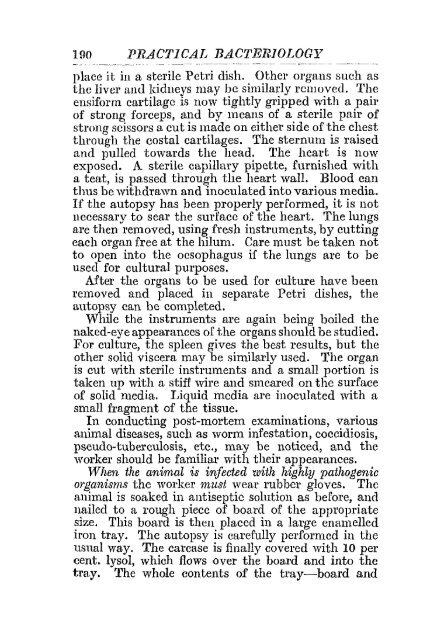AGf~ICULTURAL RESEARCH, PUSA.
AGf~ICULTURAL RESEARCH, PUSA.
AGf~ICULTURAL RESEARCH, PUSA.
You also want an ePaper? Increase the reach of your titles
YUMPU automatically turns print PDFs into web optimized ePapers that Google loves.
190 PRACTICAL BA.CTER10LOGY<br />
place it ill a sterile Petri dish. Other organs such as<br />
the liver and kidneys may be similarly removed. The<br />
ensiform cartilage is now tightly gripped with a pair<br />
of strong forceps, and by means of a sterile pair of<br />
strong scissors a cut is made on either side of the chest<br />
through the costal cartilages. The sternum is raised<br />
and pulled towards the head. The heart is now<br />
exposed. A sterile capillary pipette, furnished with<br />
a teat, is passed through the heart wall. Blood can<br />
thus be withdrawn and inoculated into various media.<br />
If the autopsy has been properly performed, it is not<br />
necessary to sear the surface of the heart. The lungs<br />
are then removed, using fresh instruments, by cutting<br />
each organ free at the hilum. Care must be taken not<br />
to open into the oesophagus if the lungs are to be<br />
used for cultural purposes.<br />
After the organs to be used for culture have been<br />
removed and placed in separate Petri dishes, the<br />
autopsy can be completed.<br />
While the instruments are again being boiled the<br />
naked-eye appeamnces of the organs should be studied.<br />
For culture, the spleen gives the best results, but the<br />
other solid viscera may be similarly used. The organ<br />
is cut with sterile instruments and a small portion is<br />
taken up with a stiff wire and smeared on the surface<br />
of solid media. Liquid media are inoculated with a<br />
small fragment of the tissue.<br />
In conducting post-mortem examinations, various<br />
animal diseases, such as worm infestation, coccidiosis,<br />
pseudo-tuberculosis, etc., may be noticed, and the<br />
worker should be familial' with their appearances.<br />
When the animal is infected with highly pathogenic<br />
organisms the worker must wear rubber gloves. The<br />
animal is soaked in antiseptic solution as before, and<br />
nailed to a rough piece of board of the appropriate<br />
size. This board is then placed in a large enamelled<br />
iron tray. The autopsy is carefully performed in the<br />
usnal way. The carcase is finally covered with 10 per<br />
cent. lysol, which flows over the board and into the<br />
tray. The whole contents of the tray-board and

















